10 Mistakes An Expert Wants You To Avoid When Cooking Spaghetti
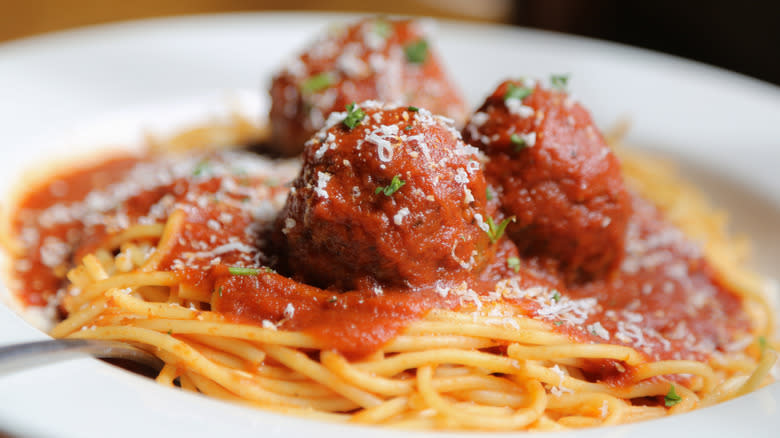
After working in kitchens for years and learning from my mistakes, it's safe to say that I know a thing or two about cooking spaghetti. Spaghetti is one of those pasta dishes that's popular because it's simple, familiar, and comforting. For many of us, it is also probably one of the first things that we learn to cook at home. I wholeheartedly believe that everyone should know how to cook a few basic things well and spaghetti is one of them.
Even though cooking spaghetti perfectly every time seems straightforward — boil the noodles and toss in sauce — the truth is that a lot of mistakes can still be made along the way. If you've ever been left with a bowl of bland and mushy noodles, then you know that things can go horribly wrong. The good news is that by avoiding the mistakes I've highlighted here, you can easily whip up a bowl of spaghetti that's consistently delicious.
Read more: 11 Of The Best Cooking Tips From Bobby Flay
Mistake: Forgetting To Salt The Water
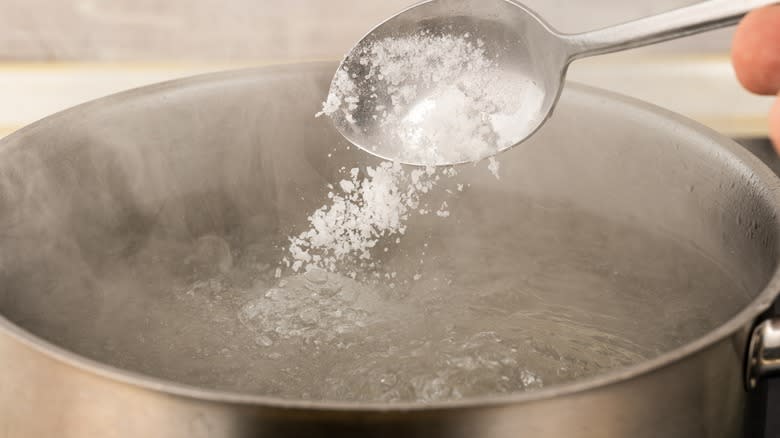
Salting your pasta water is the first step to making good spaghetti. The reason this is important is because the salt from the water is slowly absorbed by the noodles, which gives the pasta a boost of flavor. Salting pasta water is such an easy thing to do, yet at the same time, because it's such a minor task it's also equally easy to forget — especially if you're busy preparing other things for the meal at the same time.
If you forget to salt the water for your spaghetti, the noodles will end up bland. If they are al dente, then all is not lost, since the pasta can finish cooking in your sauce, which will also give it more flavor. But the truth is that if you forget to salt the water, there's no real way to fully infuse those noodles with that salt once they've finished cooking. The real key here, like with any other task in life, is to just try and stay mindful.
That said, make sure you don't oversalt the water, either. A good rule of thumb is that you should add about a tablespoon or so for every 4 quarts of water; be sure to taste the pasta water (in a spoon once it's cooled a bit, of course) to ensure it's at your desired level of saltiness. It's also advisable to use kosher salt instead of iodized salt, as the latter can impart an unpleasant bitterness.
Mistake: Using A Big Pot

Contrary to popular belief, you don't need to use a big pot of water to make pasta. Big pots of water take a long time to boil, and you can save time by boiling pasta in a big skillet or a large saucepan instead. Because these pans aren't as deep as big pots, they'll reach a boil much faster. The trick here is that you need to be a bit more attentive and stir the pasta more frequently to ensure it doesn't stick together.
Of course, this also largely depends on how much pasta you're cooking. If you work in a professional kitchen as I have, then there are probably times that you need to cook pasta in bulk, which often requires an industrial kettle. Obviously, busting out a saucepan to cook pasta in this situation would be ridiculous; a big pot is absolutely necessary when cooking large amounts of pasta. But if you're only cooking pasta at home for just a few people, try using a skillet or a saucepan so that you don't have to wait for a big pot to boil.
Mistake: Adding Oil To The Water
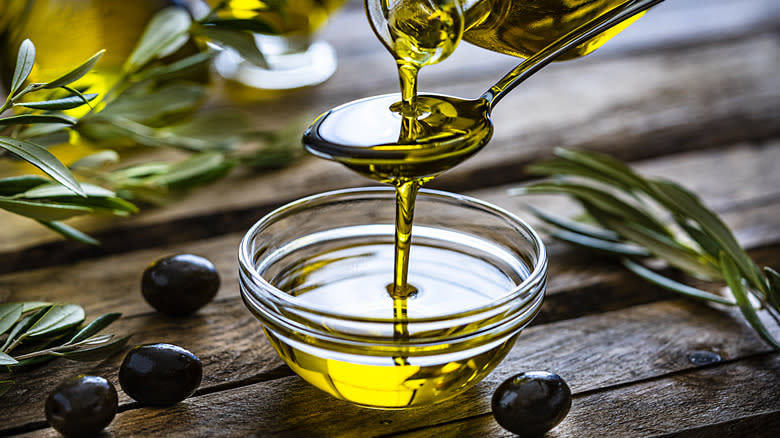
Once upon a time before I knew any better, I added oil to my pasta water. Like many of you, I was told that it would prevent the noodles from sticking. As it turns out, that's not really true.
What ends up happening is that because oil is less dense than water, it ends up floating on top in little pools. Then when the pasta is strained, the noodles get immediately coated in oil, which can make it less receptive to sauce. Since the whole goal here is to unify our pasta with our sauce, adding oil to the water is counterproductive.
The one exception here might be pesto. Because pesto is so heavily oil-based, incorporating oily noodles into it probably won't be much of a problem. But if you're working with a tomato-based sauce, then trying to mix oily noodles into it probably won't work out very well. Let's face it: All you're really trying to accomplish here by adding oil is to prevent the noodles from sticking, right? Instead of adding oil, the real solution is to just keep an eye on your pasta and keep stirring the noodles.
Mistake: Leaving The Lid On

Of course, leaving the lid on while you're waiting for the water to boil for your spaghetti is totally fine and makes perfect sense. Because the lid traps in heat and moisture, this allows the water to reach a boil faster. But once you've added the spaghetti to the boiling water, putting the lid back on at this point is a mistake.
There are a couple of reasons why leaving the lid on at this stage is a bad move. First, it blocks your visibility. Even if the lid is made of glass, it will immediately steam up so that you can't see the noodles inside. This makes it more likely that you won't be able to tell if the noodles are sticking together; it also means that you probably won't stir the noodles as frequently (since the lid is in the way and blocks easy access).
But the main problem here is that keeping the lid on is likely to cause an overflow of pasta water. The lid will trap so much heat and moisture that it's bound to bubble up and spill out onto the stovetop, causing puddles of starchy pasta water to burn. The bottom line is that you have nothing to really gain by leaving the lid on; you're really just increasing your chances of making a mess that you'll have to clean up.
Mistake: Not Saving The Leftover Pasta Water
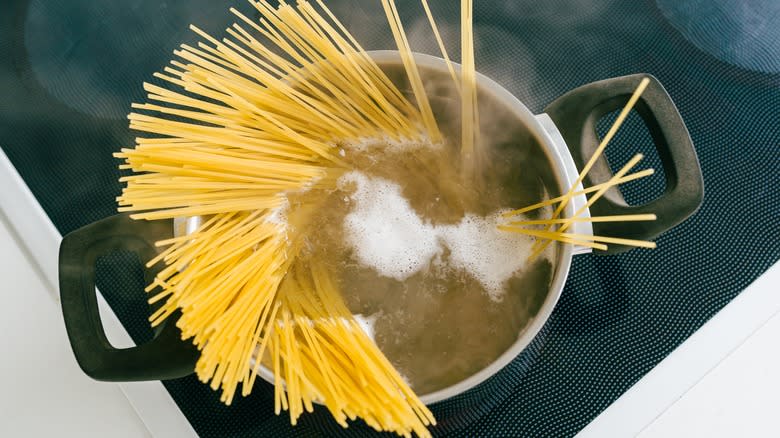
Like all novices early on, there was a time when I dumped all of my pasta water down the drain, totally unaware of how I was discarding the key ingredient to a beautiful sauce: liquefied starch. But those days are long behind me and I know better now (cue Curtis Mayfield's "Move on Up"). These days, I always make sure to save pasta water before I strain my noodles and store it in the fridge or freezer for later because I'm fully cognizant of how valuable all of that starchy goodness is.
As pasta cooks, the starches in the noodles are released into the water. This is why pasta water ends up looking cloudy and takes on a slightly more viscous consistency. Mixing some of this starchy water into pasta sauce will help it stick to the noodles better, and simmering everything together will help the sauce thicken and bind to the pasta. Essentially, pasta water acts as an emulsifier. If you want to make a bangin' bowl of spaghetti, the last thing you want to do is toss that pasta water down the drain.
Mistake: Using Jarred Garlic
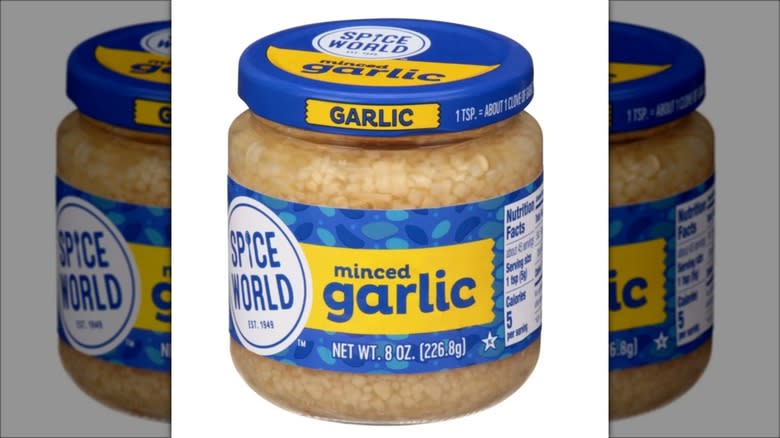
Look, I get it. Using jarred garlic makes cooking easier, and when you're pressed for time, corners need to be cut. There are a lot of mistakes people make when using garlic and opting for the jarred version is one of them. Sadly, fresh garlic often ends up getting abandoned because peeling its papery skin and chopping it up can be a bit tedious. But in my opinion, this is a case where the juice is worth the squeeze. Fresh garlic has a deliciously vibrant flavor that jarred garlic just can't compete with.
A part of the problem is that jarred garlic is often immersed in a brine to help preserve it and make it shelf stable. This essentially ends up giving it a slightly pickled taste that drains the garlic of its natural flavor. Jarred versions also tend to take on a bitterness that's quite unpleasant.
Think about it: How much time is using jarred garlic really saving you? Just a couple of minutes? How much garlic do you really need when you cook? In most cases, you probably just need a few cloves, and if you grate them against a microplane, they can be turned into paste in a matter of seconds. All you really have to do here is peel off the skin and you'll be rewarded with an amazing level of freshness that's totally worth it. For the sake of your spaghetti, ditch the jarred stuff and keep it fresh.
Mistake: Browning Your Garlic
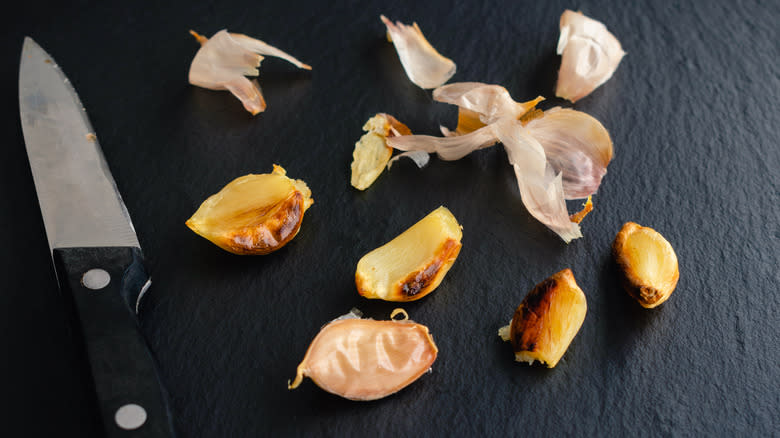
There is a fine line between cooked and burned garlic. In a matter of seconds, those yellowed bits can turn brown and burn, instantly transforming them into an inedible mess. The reason that garlic burns so easily is because it has a very low water content. When garlic burns, it becomes extremely bitter and will definitely ruin the flavor of your spaghetti.
What this really comes down to is patience and timing. Rather than sauteing the garlic on high heat to cook it quickly, keep your heat at a lower setting to cook it slowly and gently. This will give it time to cook and slowly release its flavors, greatly reducing the chance of it burning. A good rule of thumb is to add your garlic once the other vegetables are cooked. So if you're sauteing minced onions for your spaghetti sauce or marinara, don't add the garlic at the same time because the garlic will cook faster and burn. Instead, add it once the onions are almost finished cooking. Once the garlic is fragrant and has taken on a light golden color, it's time to remove it from the heat.
Mistake: Buying Premade Spaghetti Sauce
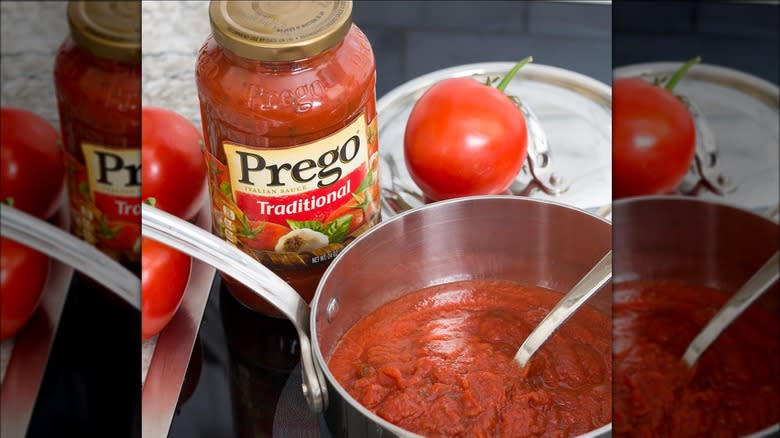
Buying premade spaghetti sauce can be tempting. It's so easy to just pop the top, dump it on some noodles, and call it a day. But the reality is that pre-made spaghetti sauce is often loaded with a lot of salt, sugar, and preservatives that give it a highly processed flavor. The good news is that it doesn't really take much effort to make spaghetti sauce from scratch using canned peeled, whole tomatoes — and it's usually cheaper, too.
All you have to do is blend whole peeled tomatoes until you've reached the consistency that you prefer. For a thinner sauce, blend longer and for a chunkier sauce, just give it a few pulses. Then saute' diced onions and fresh garlic, season with salt, pepper, and oregano, and add your tomato puree. Bring the sauce to a low simmer and cook until it thickens up a bit. Season to taste — it may need a touch of sugar to balance out the flavors.
This simple recipe is much tastier than the highly processed premade spaghetti sauce you'll find in grocery stores. The quality of spaghetti is largely dependent upon the quality of the sauce, and there's no better way to upgrade basic tomato sauce than by making it fresh.
Mistake: Overcooking The Spaghetti Noodles
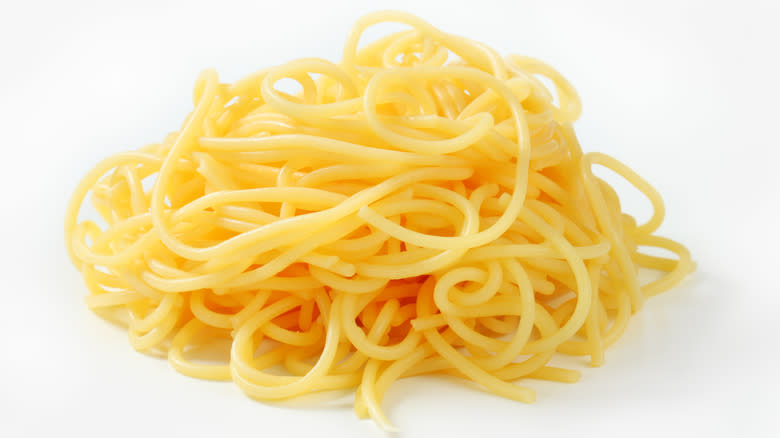
Maybe you're sipping on a little wine in the kitchen while you're cooking, listening to music, daydreaming about how good your spaghetti is going to be. Then you realize that you haven't checked the noodles for a while, and when you strain them, you're left to face a harsh reality: The spaghetti is overcooked. To make matters worse, the noodles are actually still cooking, immersed in swirling steam from the piping hot water they were previously plunged in, getting mushier by the second. Overcooking spaghetti happens to the best of us -- we've all been there.
Still, there's no denying that overcooking spaghetti pretty much ruins the meal. Which is why it's so important to prevent it from happening. It's far better to have undercooked spaghetti than overcooked, because once it's overcooked, there's no turning back. The trick is to stop boiling your pasta once it's nearly al dente, and then finishing it by simmering it in your sauce. This allows the noodles to absorb the sauce and take in more flavor; it also makes it much easier to accurately gauge the pasta's level of doneness.
Mistake: Rinsing The Noodles
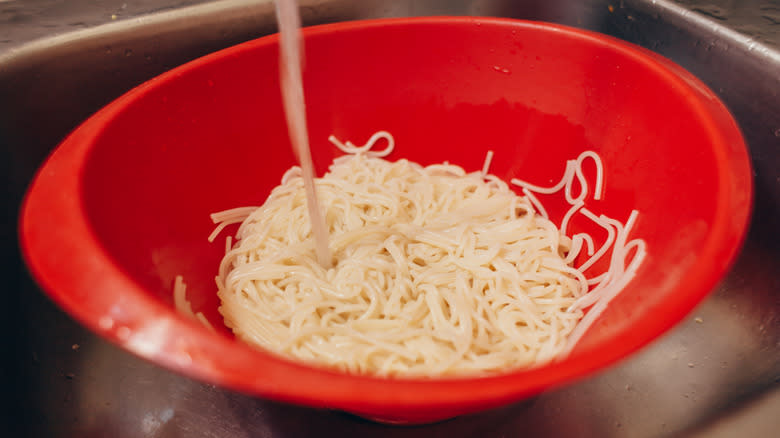
To be clear, sometimes rinsing pasta noodles makes sense. If you're making lasagna, rinsing the noodles will cool them down quicker and also stop them from continuing to cook. The downside here is that rinsing the lasagna noodles also washes away their residual starches, which will make it harder for the sauce to cling to them. But in this case, losing some of those starches won't matter much, because the lasagna noodles will be baked with the sauce in the oven for a while. This will give everything a chance to bind together.
Unlike lasagna, spaghetti doesn't get baked in the oven. So when the starches are rinsed off and washed away, the pasta doesn't get another chance to fuse with the sauce. If you want your pasta to stop cooking, rather than running cold water over the noodles and washing away the starch, it's better to just plunge them into some room temperature sauce.
Read the original article on The Daily Meal.

